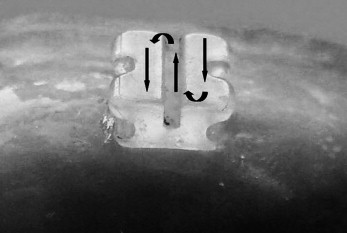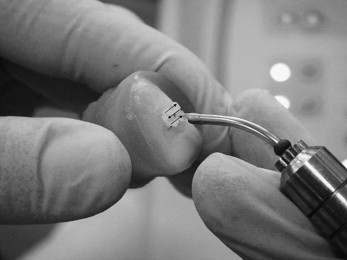Introduction
The purpose of this in-vitro study was to develop a new method to debond ceramic brackets by scanning with an Er:YAG laser.
Methods
Sixty bovine mandibular incisors were randomly divided into 2 groups of 30. Polycrystalline ceramic brackets were placed on their labial surfaces by using the orthodontic composite adhesive Transbond XT (3M Unitek, Monrovia, Calif) and light cured for a total of 40 seconds. The first group was the control group, with no laser application performed. The Er:YAG laser was used on each bracket in the study group at 4.2 W for 9 seconds with the scanning method. The force required for debonding the brackets was applied 45 seconds after laser exposure. Shear bond strengths were measured in megapascals with a universal testing machine, and adhesive remnant index scores were assigned to each specimen.
Results
Statistically significant ( P <0.001) lower shear bond strengths were found in the laser group (9.52 MPa) compared with the control group (20.75 MPa). Likewise, the adhesive remnant index scores were statistically different ( P <0.001); the laser group had twice as many samples with adhesive, with the adhesive remnant index scores of 2 or 3.
Conclusions
The application of the Er:YAG laser with the scanning method is effective for debonding ceramic brackets by degrading the adhesive through thermal softening.
Within the past few years, ceramic brackets have gained popularity as the numbers of adult patients increase. Even though they have superior esthetic advantages compared with their metal counterparts, ceramic brackets can lead to problems such as enamel tear outs, bracket failures, and pain at removal because of their low fracture resistance and high bond strengths. Several debonding techniques including wood-burning pens, warm-air dryers, ultrasonic instruments, electrothermal devices, and lasers have been used to overcome problems during debonding. With these techniques, debonding is achieved by thermal softening of the adhesive resin by heat conductivity. Studies concerning this issue emphasize laser debonding, which is an effective way that works by controlling the amount of thermal energy delivered.
The efficacy of lasers on debonding has been evaluated in several studies with many variables and techniques—eg, types of lasers with the same and different energy levels, brackets, resins, and magnitude of stresses—that are applied. Despite the many variables, in all of these studies, the force to remove the bracket was applied immediately after lasing or during lasing.
Strobl et al investigated the removal of polycrystalline and monocrystalline alumina brackets using carbon dioxide and YAG lasers. They used the laser beam shutter for the experimental set-up, which had a thermally insulated fork to prevent fast cooling of the bracket. As soon as the laser beam shutter closed, a motorized translation stage pushed the mechanism for shearing off the bracket. Their results showed that laser-aided debonding significantly reduced debonding force by thermal softening of the resin. When the average torque force was considered, they found that monocrystalline brackets required less laser energy for debonding than polycrystalline brackets.
Tocchio et al used laser light at wavelengths of 248, 308, and 1060 nm at power densities between 3 and 33 W per square centimeter to debond 2 types of ceramic brackets by externally applied stress of either 0 or 0.8 MPa. No enamel or bracket damage was reported as a result of laser debonding. According to the investigators, laser energy can degrade the adhesive resin by thermal softening, thermal ablation, or photoablation. Thermal softening happens when the bonding agent is heated until it softens. As the result of thermal softening, the bracket slides off the tooth surface. If the heating is fast enough to raise the temperature of the resin into its vaporization range before thermal softening occurs, thermal ablation takes place. The bracket blows off the tooth surface as the result of thermal ablation. The bracket also blows off the tooth from photoablation, which occurs when the energy level of the bonds between the bonding-resin atoms rapidly rises above their dissociation energy levels, resulting in the decomposition of the material.
Debonding with thermal softening occurs at low power densities, whereas thermal ablation and photoablation happen at high power densities. All monocrystalline brackets were debonded in less than 1 second by either thermal ablation or photoablation. The brackets still felt cool after debonding, since thermal ablation and photoablation proceeded rapidly with little heat diffusion that caused the tooth and the bracket to stay near physiologic temperatures. On the other hand, polycrystalline brackets were too hot to touch because they were debonded by sliding down under the influence of the applied force as a result of thermal softening. However, in their study, no intrapulpal temperature change was measured.
Mimura et al used a carbon dioxide laser to investigate the differences in the laser-aided debonding mechanism between 2 adhesives. They evaluated these adhesives according to debonding force, debonding time, total illuminated laser energy, and modified adhesive remnant index. Unlike previous studies, they applied the force and the lasing simultaneously. They concluded that the laser-focused adhesives tended to be removed with the brackets in the Bis-GMA groups, whereas the adhesives tended to remain on the tooth surface in the MMA groups.
Ma et al and Rickabaugh et al used carbon dioxide lasers and modified debonding pliers to accurately position the laser beam on the ceramic bracket. In accordance with previous studies, their results showed significant differences in tensile debonding forces between the control and study groups. They also stated that the bracket could be removed from the tooth with pliers as soon as the adhesive-softening temperature had been reached, and the debonding pliers holding the bracket reduced the possibility of dropping it on the patient. Additionally, quick removal of the bracket prevented the heat energy stored in the bracket from transmitting to the tooth.
Obata et al investigated bonding and debonding of ceramic brackets in vitro and in vivo with super-pulse and normal-pulse carbon dioxide lasers. An in-vivo study was performed for the removal of brackets by 1 operator in which a rotational force was applied with tweezers to disengage the bracket after lasing each tooth. The shear force was then measured in vitro by using 2 and 3 W generated by the super-pulse laser. They concluded that super-pulse carbon dioxide laser debonding is clinically more useful than laser etching for orthodontic treatment.
Hayakawa stated that ceramic brackets were debonded effectively using a high-peak power Nd:YAG laser at 2.0 J or more. The laser energy was applied to the mesiodistal centers of the gingival surface and the coronal surface under each bracket wing, which is labiolingually the thinnest part of the ceramic bracket. The shear test was performed after the laser pulse had been applied; however, the time interval between the shear test and the lasing was not mentioned.
All of these previous studies confirm the efficiency of laser debonding of ceramic brackets. On the other hand, possible side effects of these different laser types, application techniques, and variables on tooth structures should be kept in mind. Therefore, to prevent undesirable results, an appropriate method that could be easily used in the clinic practice should be developed.
The purpose of this in-vitro study was to develop a new method to debond ceramic brackets by scanning with an Er:YAG laser.
Material and methods
Sixty freshly extracted, noncarious bovine permanent mandibular incisors were used in this study because of their similar properties to human enamel. The roots were cut away, and soft-tissue debris and coronal pulps were removed. The prepared samples were stored in 0.1% thymol solution until use.
The bonding surfaces of the enamel were polished with a nonfluoridated pumice paste for 15 seconds, rinsed, and dried with compressed air. The teeth were then conditioned with 37% phosphoric acid for 30 seconds, followed by thorough washing and drying. Sixty polycrystalline alumina brackets (Transcend series 6000, 3M Unitek, Monrovia, Calif) were bonded by 1 operator (M.O.Ö.). Force was applied until the composite material overflowed from all margins of the brackets and the base of the brackets touched the labial surfaces of the incisors. Orthodontic composite adhesive Transbond XT (3M Unitek) was used and cured with a halogen light-curing unit (Optilux, Kerr, Orange, Calif) for 20 seconds on the mesial and distal sides, as recommended by the manufacturer. Each tooth was adjusted with a guiding device to reproducibly position the bracketed teeth during testing. The teeth were embedded in an autopolymerizing epoxy resin (Fortex Cold Curing Dental Polymer 2000; Willmann & Pein GmbH, Hamburg, Germany) with the labial surfaces and the brackets exposed. Before testing, all samples were stored in distilled water at 37°C for 48 hours.
The teeth were randomly assigned to 2 groups of 30 brackets to be debonded with and without lasing. The laser we selected was the Er-YAG (DEKA Smart 2940 D Plus, VersaWave, HoyaConbio, Fremont, Calif) at a power of 4.2 W with a wavelength of 2940 nm. The laser energy was applied by scanning thoroughly the surface of the brackets for 9 seconds. Scanning was done with horizontal movements parallel to the bracket slot starting from the upper distal wing of the bracket to the upper mesial wing, and then to the slot of the bracket and the lower wings ( Figs 1 and 2 ). The application tip with a diameter of 1 mm was positioned perpendicularly 2 mm from the bracket.


The shear test was performed 45 seconds after the laser pulse had been applied. In clinical practice, for lasing the 5 teeth on the half arch before debonding, a total of 45 seconds is necessary when each tooth is lased for 9 seconds. To evaluate the bond strength of each specimen, the shear bond strength was measured with a universal testing machine (Instron, Canton, Mass) with a shear blade. The force was applied to the bracket occluso-gingivally, producing a shear force at the bracket-tooth interface. A computer electronically connected to the testing machine recorded the results of each test. Shear bond strengths were measured in megapascals at a crosshead speed of 1 mm per minute. The bracket bases and the enamel surfaces were examined under a light stereomicroscope at 20-times magnification, and the adhesive remnant index (ARI) scores were assigned to each specimen. A score of 0 indicated that no adhesive was left on the tooth in the bonding area, 1 indicated that less than half of the adhesive was left on the tooth, 2 indicated that more than half was left on the tooth, and 3 indicated that all adhesive was still on the tooth with a distinct impression of the bracket mesh on the remaining adhesive surface.
Statistical analysis
Statistical calculations were performed with Prisma software (version 3.0, GraphPad, San Diego, Calif) for Windows. In addition to standard descriptive statistical calculations (means and standard deviations), an unpaired t test was used in the comparison of the groups, and a chi-square test was performed to evaluate the qualitative data. A Spearman correlation test was used for variables correlation. The statistical significance level was established at P <0.05.
Results
The results showed statistically significant differences between the control and study groups ( P <0.001). The shear test showed significantly lower shear bond strengths in the laser group. The data are summarized in Tables I through III Chi-square analysis determined that the ARI scores were statistically different ( P <0.001; Table III ).
| Group | Mean | SD | P |
|---|---|---|---|
| Control | 20.75 | 3.96 | <0.001 |
| Laser | 9.52 | 3.06 | <0.001 |



